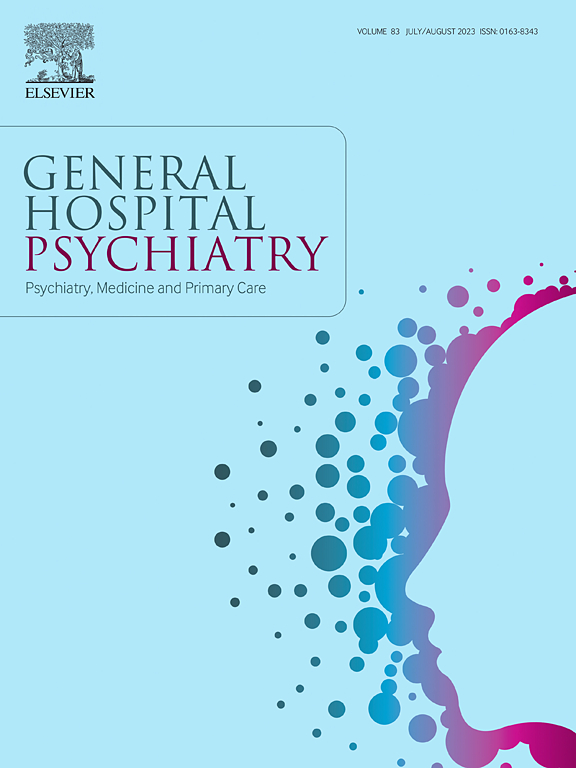Functional limitations and suicidal ideation: Independent, interactive, and cumulative associations in a nationally representative sample
IF 3.7
2区 医学
Q1 PSYCHIATRY
引用次数: 0
Abstract
Background
Suicidal ideation is a critical public health issue, often linked to functional limitations that hinder daily activities. However, the independent, interactive, and cumulative effects of specific types and quantities of functional limitations on suicidal ideation remain underexplored.
Methods
Data were analyzed from 12,263 U.S. adults in the National Health and Nutrition Examination Survey (NHANES, 2013–2018). Functional limitations were assessed across six domains: vision, hearing, cognitive, mobility, dressing/bathing, and errands. Multivariable logistic regression and interaction models were used to examine associations between functional limitations and suicidal ideation. Dose-response relationships were evaluated using restricted cubic spline regression.
Results
Vision (OR = 1.77, 95 % CI = 1.00–3.13), cognitive (OR = 5.52, 95 % CI = 3.63–8.39), and errand limitations (OR = 1.75, 95 % CI = 1.09–2.79) were independently associated with suicidal ideation. A significant interaction effect was observed between hearing and cognitive limitations, with the co-occurrence amplifying suicidal ideation risk (OR = 5.80, 95 % CI = 3.84–8.78). Additionally, a dose-response relationship was found, with individuals experiencing ≥5 limitations having the highest risk.
Conclusions
Functional limitations, particularly cognitive and errand-related impairments, are strongly associated with suicidal ideation. Interaction effects and cumulative impacts underscore the need for integrated mental and physical healthcare approaches. Tailored interventions targeting specific limitations and addressing cumulative burdens may mitigate suicidal ideation in this vulnerable population.
功能限制和自杀意念:在全国代表性样本中独立、互动和累积的关联
背景自杀意念是一个重要的公共卫生问题,通常与妨碍日常活动的功能限制有关。然而,特定类型和数量的功能限制对自杀意念的独立、互动和累积影响仍未得到充分探讨。方法分析全国健康与营养检查调查(NHANES, 2013-2018)中12263名美国成年人的数据。功能限制在六个领域进行评估:视觉、听力、认知、活动、穿衣/洗澡和差事。多变量逻辑回归和相互作用模型被用来检验功能限制和自杀意念之间的关系。使用限制三次样条回归评估剂量-反应关系。结果视觉(OR = 1.77, 95% CI = 1.00-3.13)、认知(OR = 5.52, 95% CI = 3.63-8.39)和差使限制(OR = 1.75, 95% CI = 1.09-2.79)与自杀意念独立相关。听力障碍与认知障碍之间存在显著的交互作用,同时存在会放大自杀意念风险(OR = 5.80, 95% CI = 3.84 ~ 8.78)。此外,还发现了剂量-反应关系,经历≥5个限制的个体风险最高。结论功能障碍,尤其是认知和工作相关障碍,与自杀意念密切相关。相互作用效应和累积影响强调需要综合的心理和身体保健方法。针对特定限制和解决累积负担的量身定制的干预措施可能会减轻这一弱势群体的自杀意念。
本文章由计算机程序翻译,如有差异,请以英文原文为准。
求助全文
约1分钟内获得全文
求助全文
来源期刊

General hospital psychiatry
医学-精神病学
CiteScore
9.60
自引率
2.90%
发文量
125
审稿时长
20 days
期刊介绍:
General Hospital Psychiatry explores the many linkages among psychiatry, medicine, and primary care. In emphasizing a biopsychosocial approach to illness and health, the journal provides a forum for professionals with clinical, academic, and research interests in psychiatry''s role in the mainstream of medicine.
 求助内容:
求助内容: 应助结果提醒方式:
应助结果提醒方式:


